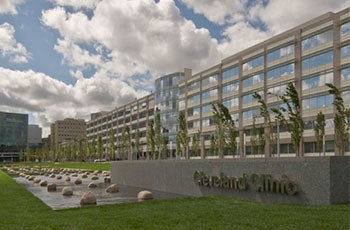Cleveland Clinic launches largest green revolving fund in health care

Cleveland Clinic invests in energy efficiency with green revolving fund.
Cleveland Clinic has established a $7.5 million green revolving fund (GRF) — the largest of its kind in the health care industry — and one of the largest in any business sector in the nation.
Cleveland Clinic announced the fund, which will finance energy-efficiency projects across its health system, during the national Better Buildings Summit in Washington, D.C., earlier this week.
“The establishment of this fund strengthens Cleveland Clinic’s commitment to reducing our energy usage and serves as a catalyst for future projects to further reduce our impact on the environment,” says Jon Utech, senior director, Cleveland Clinic’s Office for a Healthy Environment.
“As a leader in health care, we are continually looking for ways to improve the health of the communities we serve and reduce our operating costs in order to make care more affordable for our patients,” Utech says.
Green revolving funds are used to invest in energy-efficiency projects to reduce energy consumption, which results in reinvesting the money saved into future energy-saving projects.
As funds are invested in energy-efficiency projects, it is replenished by reinvesting savings from reduced energy consumption, in addition to any rebates received.
The GRF will help to drive Cleveland Clinic’s continued commitment to energy conservation and overall sustainability. Its goal is to reduce energy intensity by 20 percent by 2020 as part of President Obama’s Better Buildings Challenge.
Through the end of 2015, Cleveland Clinic had reduced its energy demand by 12.3 percent across its portfolio of more than 60 buildings and 20 million square feet compared with a baseline year of 2010. Several key components to Cleveland Clinic’s early success in the Better Buildings Challenge include:
- Improving the energy efficiency of its existing facilities by optimizing building systems.
- Utilizing Energy Star-rated lighting appliances and equipment.
- Implementing an LED lighting retrofit strategy as well as numerous other energy-reduction projects such as retrocommissioning and replacing inefficient HVAC equipment and systems.
Utech says Cleveland Clinic has been committed to saving energy for the past several years and establishing the GRF furthers its commitment. The GRF was financed through the health system’s capital fund.
“The green fund deepens our commitment with a formal practice of what we’ve already been doing,” Utech says. Saving energy is not only the right thing to do, but it demonstrates the health system’s efforts to reduce pollution and keep the communities it serves healthy, he adds.
Establishing the GRF is part of the Sustainable Endowments Institute’s Billion Dollar Green Challenge. The challenge encourages colleges, universities and other nonprofit institutions to invest in self-managed green revolving funds, with the goal of creating a combined total of $1 billion in funding.
“We are honored to welcome Cleveland Clinic to the Billion Dollar Green Challenge and are excited about their commitment to developing the largest green revolving fund in the health care field,” says Mark Orlowski, executive director, Sustainable Endowments Institute.
“We're enthusiastic that more hospitals will follow their leading example and commit to investing in deeper building energy efficiency through self-managed green revolving funds to reap significant financial and environmental benefits,” he says.
To date, 57 institutions have committed a total of $117 million to energy-efficiency upgrades by developing green revolving funds as part of the Billion Dollar Green Challenge. With a few exceptions, participants in the program are universities and colleges with the goal of attracting more health systems.
Visit Cleveland Clinic’s website for more information about its energy conservation and sustainability efforts, and check out the Sustainable Endowments Institute’s website to learn more about its Billion Dollar Green Challenge.




